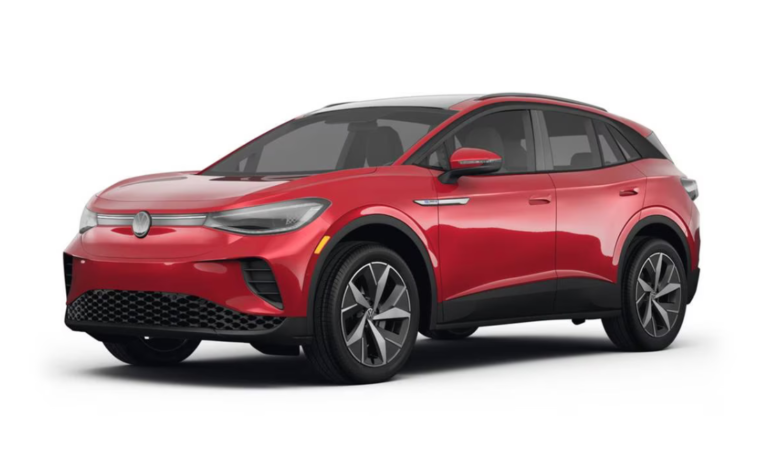
Last year, Volkswagen debuted a new all-wheel-drive version of the Volkswagen ID.4, its first electric SUV. This variation lowered the range but gave the electric crossover’s portfolio a more powerful, sporty alternative. The new ID.4 is distinct from earlier model years thanks to a few internal and external stylistic changes aimed at appealing to families and making an impression on American drivers. For American consumers, the updated centre console and new wheels stand out above the others. Additionally, the new Tennessee manufacturing site will probably qualify for ID.4 for federal tax refunds under the recently approved Inflation Reduction Act.
The ID.4 will also get a less costly version for 2023 called “Standard,” which would reduce the range of a 62 kWh battery pack to only 209 miles. With improved charging speeds of 140 and 170 kW, the entry-level ID.4 and those with the larger 82 kWh battery provide 10-80% quick charge periods of 29 and 30 minutes, respectively. The lengthy trims list has Standard at the top, then Pro, AWD Pro, S, Pro S, AWD Pro S, Pro S Plus, and AWD Pro S Plus.
The ID.4’s styling and driving characteristics will seem much more upscale when compared to other cost-effective EVs like the Hyundai Kona Electric, Kia Niro EV, Chevrolet’s Bolt EV, and EUV. The ID.4 has a somewhat greater range for the money when compared to the Hyundai Ioniq 5, Subaru, and Toyota Solterra-bZ4X siblings. Additionally, VW intends to attract customers with the ID.4’s effective use of space compared to small gasoline-powered crossovers like the Honda CR-V and Toyota RAV4 Prime.
Even though the single-motor ID.4 Standard ($38,790 plus a $1,295 destination fee) feels just powerful enough when taking corners or speeding through urban areas; the AWD version’s 295 horsepower ($46,590 for the Pro AWD) allows it to handle freeway on-ramps and highway overtaking more quickly because of its superior grip and more instantly available torque. Switching between the Eco, Comfort, Sport, and Traction drive modes will change the steering weight and traction control settings. However, considering the starting price of $52,590 for the most expensive AWD Pro S Plus trim, it seems unnecessary that this model does not have electrically adjustable shocks.
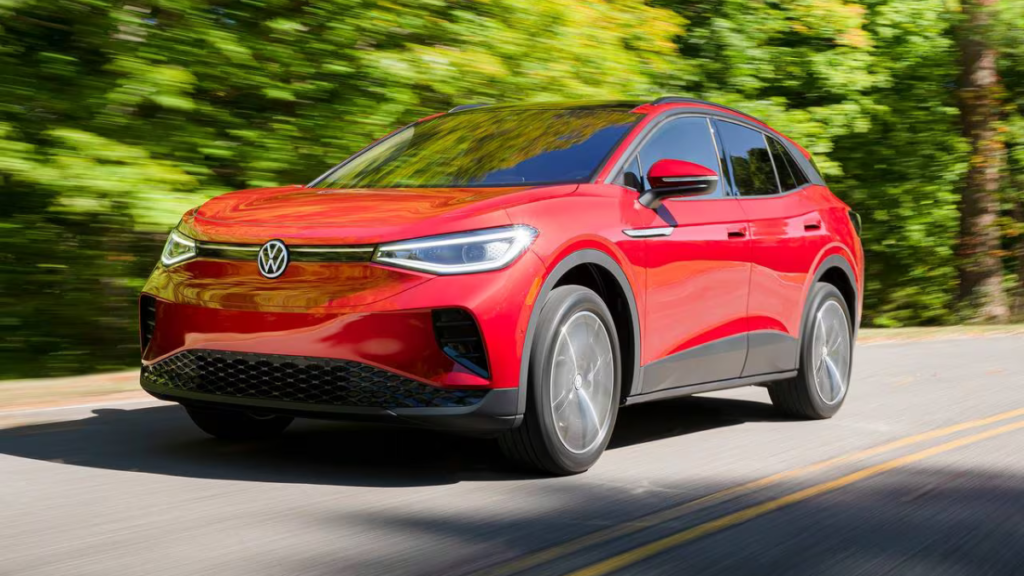
In collaboration with the Tennessee Valley Authority, which oversees the state’s electrical system, Volkswagen also unveiled a fun project: a limited edition of 1,200 ID.4s with 18-inch wheels wrapped in knobby all-terrain tires, a roof basket, and a graphics package. But make no mistake: the ID.4 offered to customers leans more toward commuter crossover than capable SUV, even with the TVA’s unique off-road features.
Volkswagen’s people-car electric vehicle is still a great choice despite the government discount because of its easy-to-drive handling, straightforward interior, less aggressively futuristic external look, and perhaps the most standard technology of any crossover available. The new Standard, with its 62 kWh battery option, would be ideal for regular family driving.
What’s New
- With a range of 209 miles, the new 62 kWh battery option lowers the introductory price to $37,495
- enhanced 170 kW rapid charging speeds with the bigger 82 kWh battery
- New wheels, paint jobs, and little stylistic changes for the outside and inside
- All trim levels come with a standard 12-inch central touchscreen.
- American production may qualify the SUV for federal tax rebates
Pros & Cons
Pros
- elegant interior with a ton of common technology
- Powerful acceleration and seamless driving experience
- AWD versions with more grip and power, as well as a less expensive single-motor RWD model
Cons
- Still not competitive with Tesla and Polestar’s entry-level range
- Using physical buttons and touchscreens is necessary to navigate the entertainment and driving modes.
- It’s still difficult to partner with Electrify America’s charging network
Performance: Volkswagen ID.4
The base ID., 4 with the new 62 kWh battery pack, is said to have 201 horsepower, and it still has the distinctive rear-wheel drive setup that sets it apart from more conventional crossovers with a front-wheel drive leaning. Stepping on the gas produces a lively burst of all-electric torque, which soon fades into dull acceleration.
Upgrading to the ID.4’s dual-motor, all-wheel-drive variants results in a noticeable boost in perceived acceleration and an output rise to 295 horsepower. Even if neither car feels particularly strong, like a Tesla, stepping straight between the two models—as clients may experience during test drives—displays the performance discrepancy during city driving and highway overtaking.
Fortunately, VW places the ID.4’s batteries in the standard skateboard configuration, which leads to a straightforward suspension design and relatively intuitive steering for a pleasant ride that can be suitably formed by turning on Sport mode. On the other hand, adjustable regenerative braking enables almost endless coasting on level terrain or descents or one-pedal driving to a complete stop. Regen also allows Volkswagen to fit the ID.4 with cheaper, simpler drum rear brakes—a nod to the original People’s Car—because they are seldom used.
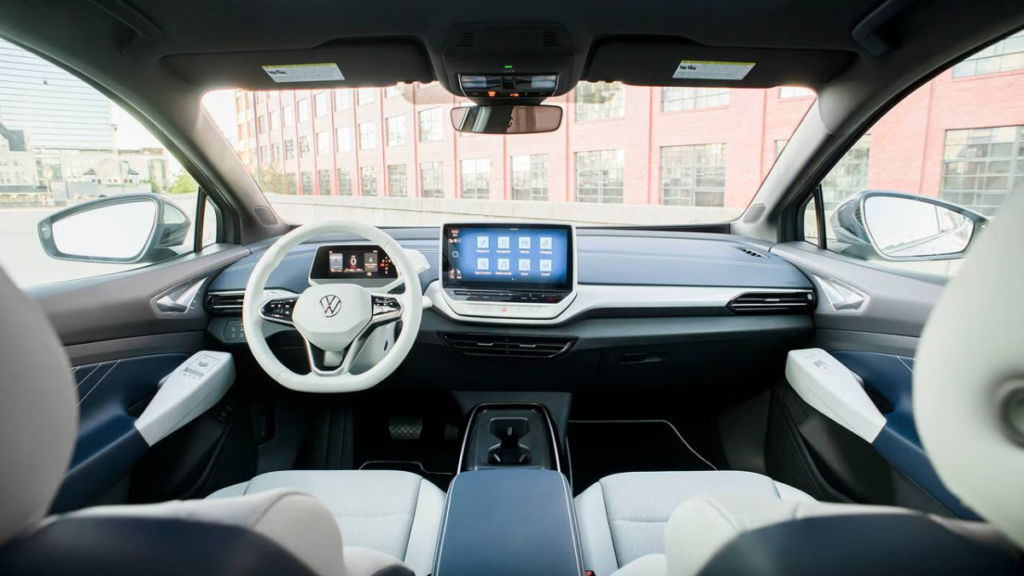
Power Consumption, Charging, and Range:
The rear-drive ID.4 Pro and Pro S variants utilize 32 kWh per 100 kilometres, compared to 31 kWh for the standard ID.4 Standard and S. Consumption for the AWD models rises to 34 kWh per 100 miles, a slight improvement over the lineup’s 2022 model year; for the RWD ID.4s, that translates to 107 mpg (mpg equivalent) on the highway and 99 mpg equivalent in the city.
In contrast, the Kia Niro EV is shorter and weighs 1,600 pounds less, translating into a 30 kWh/100 miles consumption rate, or 112 MPGe. With a range of 258 miles, the even smaller and lighter Hyundai Kona Electric consumes 27 kWh per 100 miles, or 120 MPGe, equivalent to the VW ID.4.
Regarding fuel efficiency, one gallon of gasoline is equivalent to 33.7 kWh. Gas-powered vehicles with front-wheel drive, such as the Honda CR-V, Nissan Rogue, and Toyota RAV4, use 3.3 gallons every 100 miles. For every 100 kilometres, the AWD variants of these cars use 3.4 gallons of fuel. Based on calculations, each ID.4 variant needs less than one-third of the energy required to go 100 miles compared to a gas rival.
In terms of pure range, the larger 82 kWh battery has a range of up to 275 miles, while the smaller 62 kWh battery has a range of 209 miles.
Driver assistance and safety:
Customers purchasing ID.4s may anticipate one of the most complete packages of driver assistance and safety features now offered on the market—the IQ. The drive technology package, new for 2023, includes a standard 12-inch touchscreen throughout the portfolio in addition to Park Assist Plus with Memory Parking.
Additional features include adaptive cruise control, a lane-centering function, a blind-spot monitor, rear cross-traffic warning, and front collision detection with automated emergency braking. Included are also emergency assist and travel assist, which halt the vehicle if the driver doesn’t respond to several warnings from the system. Travel assist combines adaptive cruise control with lane keeping. Standard features include automatic high beams, park distance management, and road sign recognition.
The rear-drive ID.4 has an overall safety rating of five stars from the National Highway Traffic Safety Administration (NHTSA). The Insurance Institute for Highway Safety (IIHS) has also given it a Top Safety Pick+ rating.
Coziness & Space: Volkswagen ID.4
The interior design of the ID.4 blends high-end materials with straightforward lines for any budget. Leatherette interior accents in either brighter “Cosmic” tones or darker “Galaxy” tints will be added to S models starting in 2023. Along with the addition of heated rear seats to the top-of-the-line S Plus specification, the previous model’s retractable centre console storage lid has been replaced with a more conventional design, ostensibly to accommodate American consumers’ expectations.
There are 41.1 inches of front legroom and 37.6 inches of back legroom in ID 4. These numbers are roughly comparable to most electric competitors; however, the ID.4 has 3 inches more headroom than the RAV4 and 2.6 inches more than the CR-V. But they are opting for the glass top, which results in a 1.5-inch decrease in back headroom.
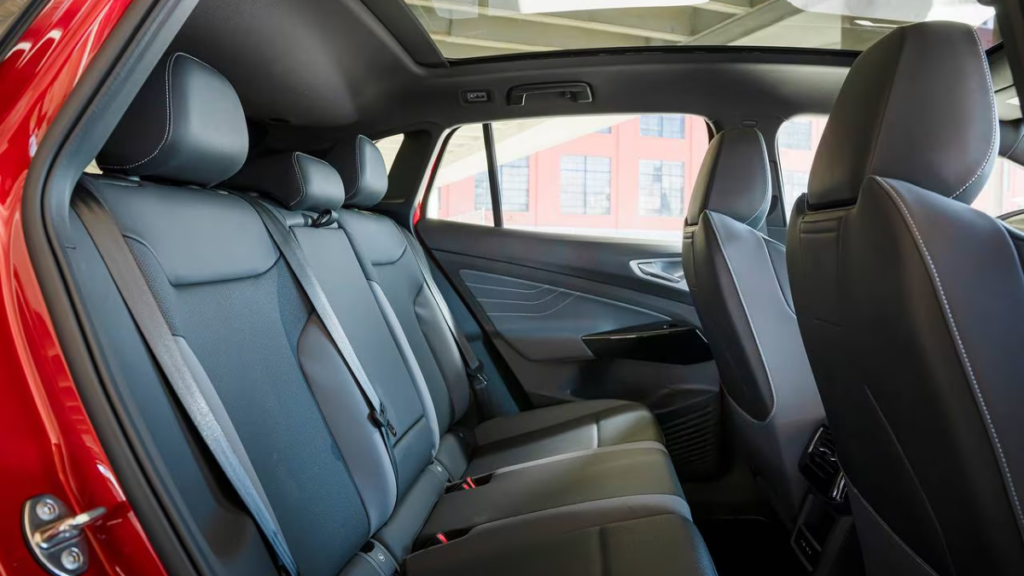
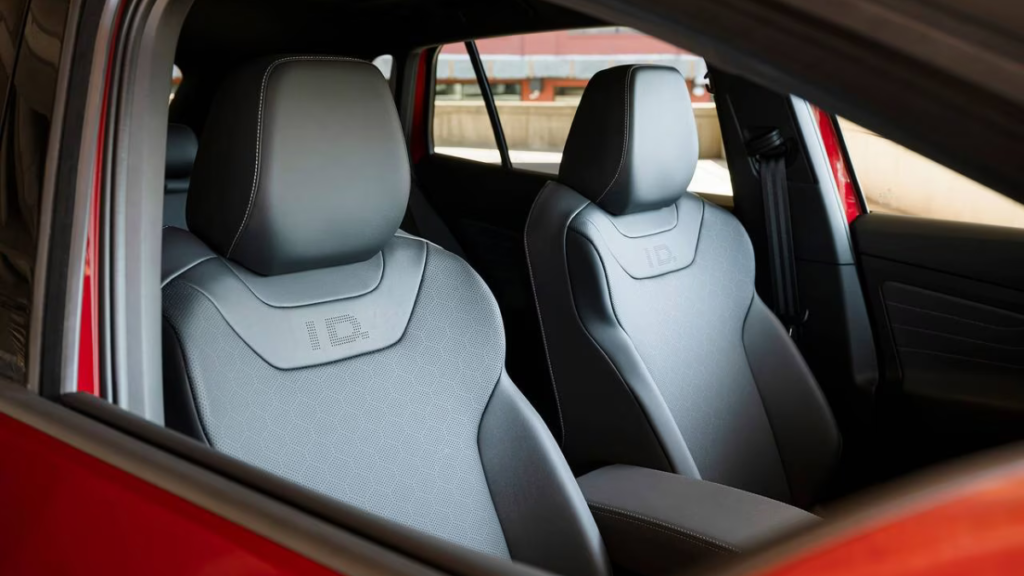
Infotainment:Volkswagen ID.4
Volkswagen prioritised technology to complement the electric drivetrain of the ID.4. Every ID.4 comes with a new 12-inch screen as standard equipment. At the same time, lesser trims on prior generations had a 10-inch touchscreen. Although several outlets and a wireless charging pad are around the cabin, the system allows wireless Apple CarPlay and Android Auto. However, switching between the central display and the minimalist gauge cluster—which rotates with the steering column—requires a sometimes confusing arrangement of menu screens and complex buttons.
It takes some getting used to even starting the ID.4. Instead of a shift lever, a knob on the steering column that is almost concealed behind the wheel lets you decide between drive, park, reverse, and regenerative braking. There are no other controls on the dash for the sound system’s volume or the temperature. The most peculiar part is that to raise or lower the rear windows, you must first pick them and then use the same control buttons as the front windows. This means that even if you concentrate on the system, the incorrect windows will always open and shut at the wrong times.
Storage & Cargo Space:
Because of its crossover design, the ID.4 has a petite body that tries to optimize internal space. Much of this spaciousness comes from the skateboard battery architecture and the absence of a front trunk; both the front and back seats have ample headroom and legroom that surpasses or equals those of gasoline-powered rivals from Toyota and Honda.
With a 60/40 folding rear seat that increases the spacious 30.3 cubic feet of luggage capacity to 64.2 cubic feet when the rear seats are folded completely flat, the back cargo room resembles that of most small crossovers. A rear cargo floor panel on Pro S models may also open to offer additional storage space under the trunk floor. It almost compensates for the absence of the typical EV front trunk, or “frunk.”
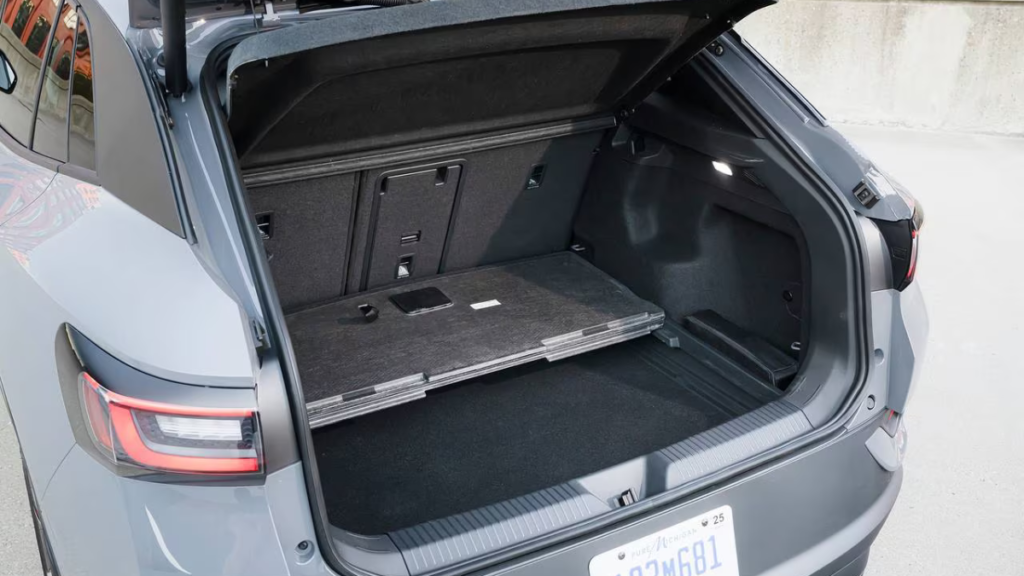
Design: Volkswagen ID.4
The 2023 ID.4’s design is reminiscent of earlier Volkswagen models, but maybe with a hint of Audi’s swooping flair. The new 2023 model year design has three new wheel designs—including 20 inches for the S models—gloss black detailing on the front and a redesigned illuminated Volkswagen logo at the back. While the overall style avoids most obviously futuristic design aspects seen on electric vehicles like Polestar, Kia, or Rivian, the lightbar headlight design complies with current industry trends.
Eight paint colours match different trim levels. The ID.4 interior’s minimalist design is carried out with crisp, precise lines. The 12-inch touchscreen is now a standard feature of the dash, and the plush heated seats with ventilation and massage functions available on higher versions further add to the sense of luxury.
Is the 2023 Volkswagen ID.4 worth it?
The new entry-level ID., 4 with the 62 kWh battery, could easily suit most everyday driving demands for urban inhabitants with short commutes and dependable access to chargers, with a 209-mile range. This is particularly true if federal tax credits further reduce the $38,790 price tag, which includes the $1295 delivery fee. If you can afford the lower range, this is the one you should get. Moving up to the most affordable all-wheel-drive model, the AWD Pro, which costs $47,590, adds a bigger battery pack, a power bump, and the assurance of improved grip. No further choices are included.
Starting at $48,790, the mid-level Pro S has a panoramic fixed-glass roof with an electronic sunshade, a leatherette inside with massaging seats, ambient interior lighting, and a motorized rear liftgate that can be opened and closed without using your hands. The AWD Pro S Plus, the most expensive vehicle in the fleet, has 295 horsepower, 256 miles of range, 2,700 pounds of towing capability, a 20-inch aluminium-alloy wheel, and more aesthetic features. It begins at $55,040.
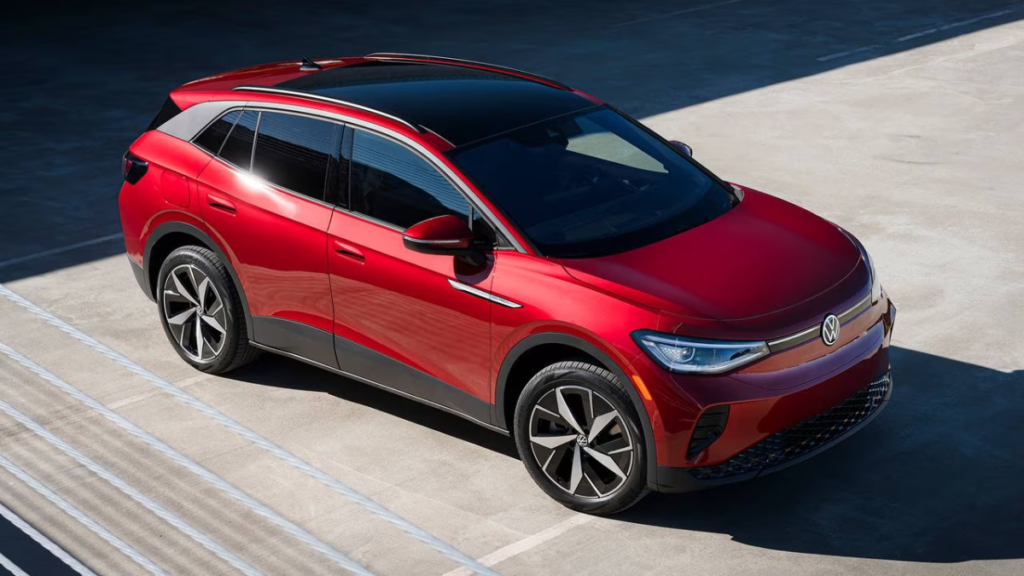
How much does Volkswagen ID.4 insurance cost in 2023?
The ID.4 should be less expensive to insure than most of its rivals. The average yearly premium for a 30-year-old female driver with a spotless record is less than $1,900, but this figure applies to all 50 states. Owners of a Hyundai Ioniq 5 may have to spend more, like $2,300 annually, compared to $2,200 for the Ford Mustang Mach-E and $2,024 for the Toyota RAV4 Prime.
Volkswagen ID.4 Generations
First Generation
2021 to Present
Using Volkswagen’s modular electric drive architecture (MEB) as its foundation, the ID.4 small crossover debuted for the 2021 model year. An 82-kWh lithium-ion battery powers an electric motor that can produce up to 201 horsepower and 228 pound-feet of torque. At the end of 2021, a 302-horsepower version with all-wheel drive and a 2,700-pound towing capacity was added to the range. A less powerful 62 kWh battery option was made available for 2023.
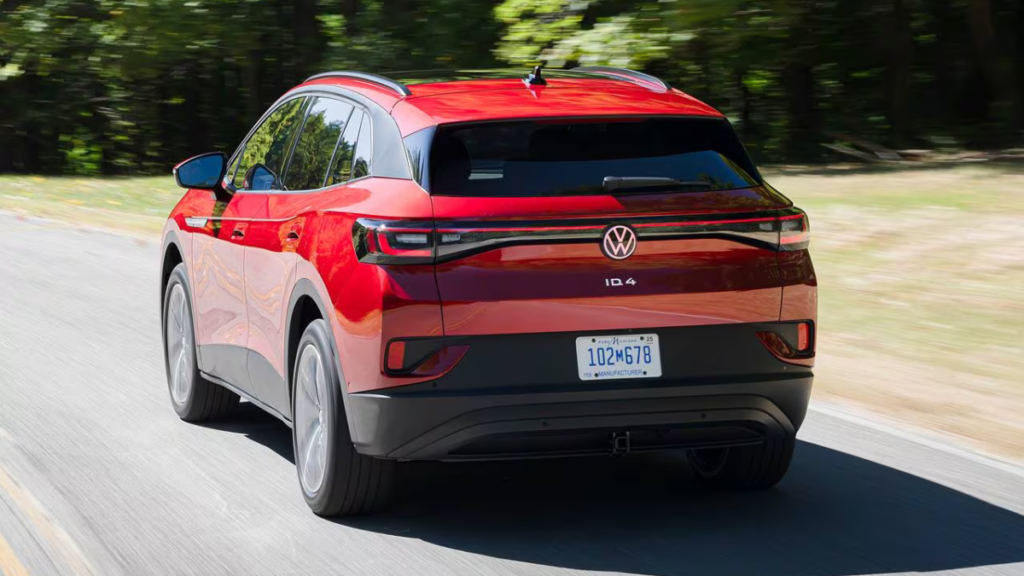
Verdict
For 2023, Volkswagen’s all-electric ID.4 crossover gets some upgrades, including a smaller primary battery, more standard features, and modest exterior and interior design changes. Most modifications are part of VW’s effort to market the ID.4 under the “Made in America, for Americans, by Americans” slogan, which alludes to an $800 million factory in Tennessee that may be eligible for government tax credits. The ID.4 will rank among the top offerings in the expanding electric vehicle market if new legislation helps lower prices. If not, eight trim levels still offer a wide range of options for almost any budget.




